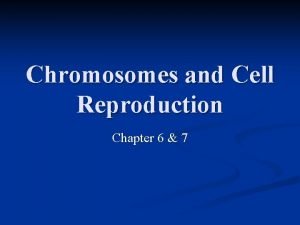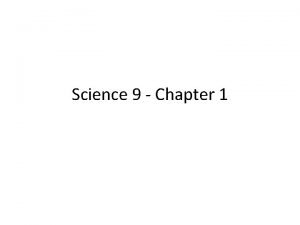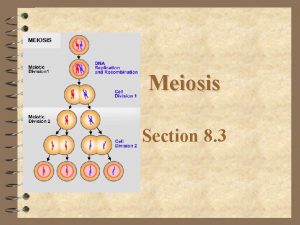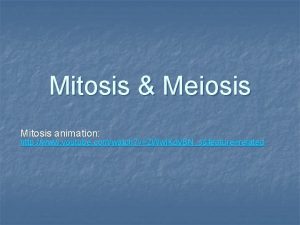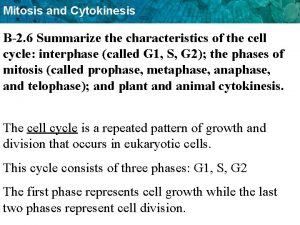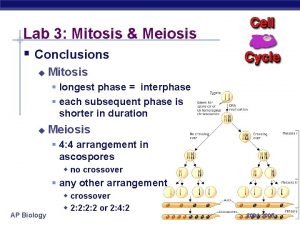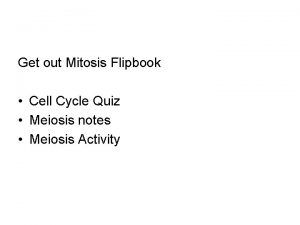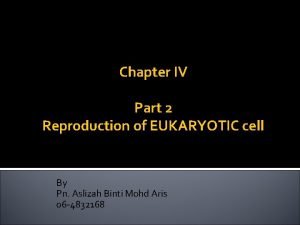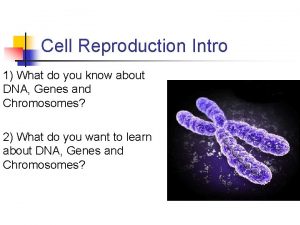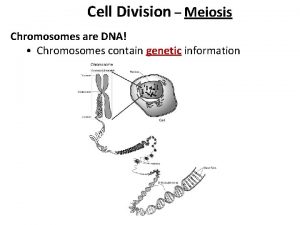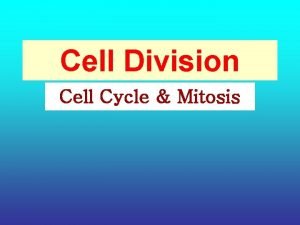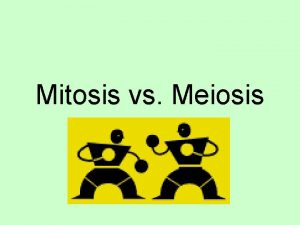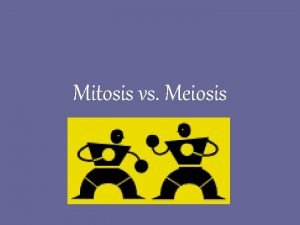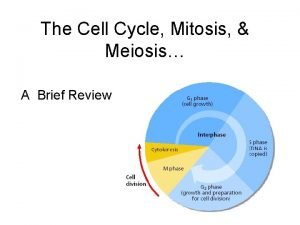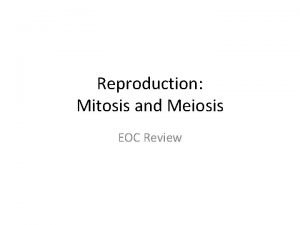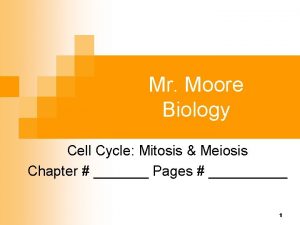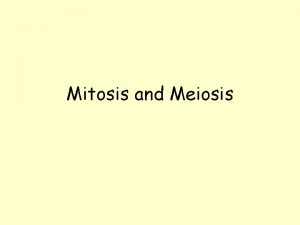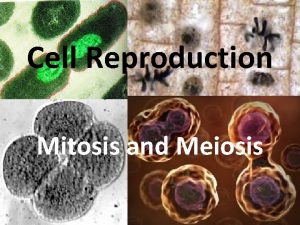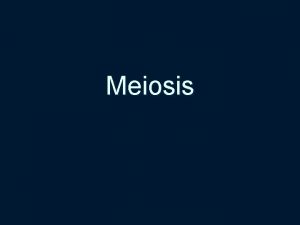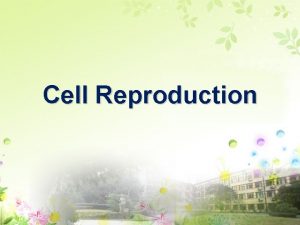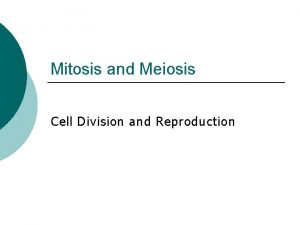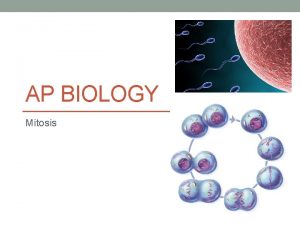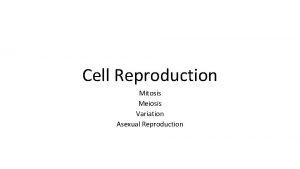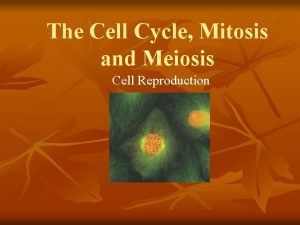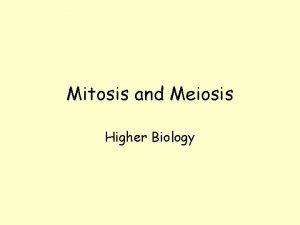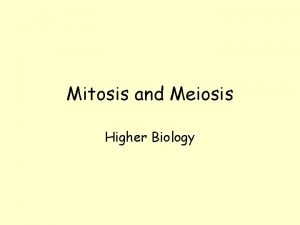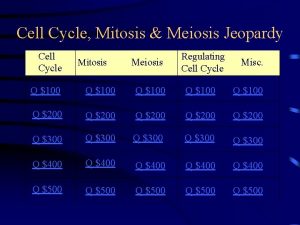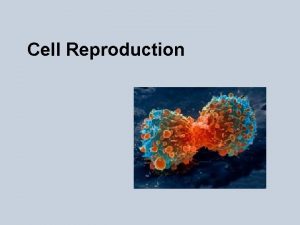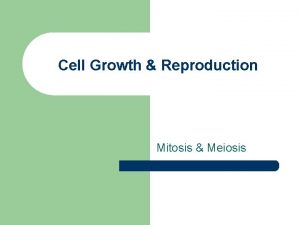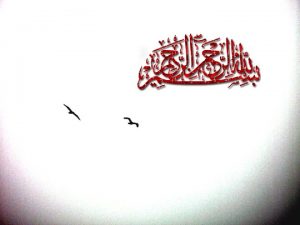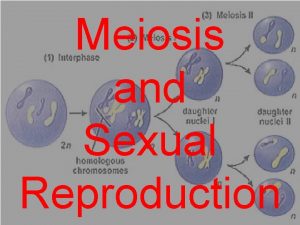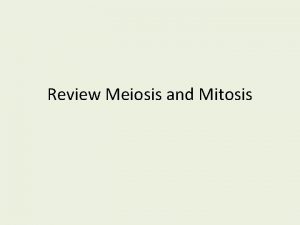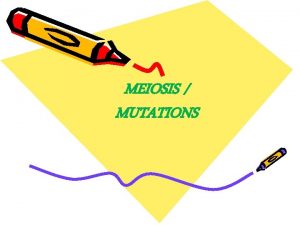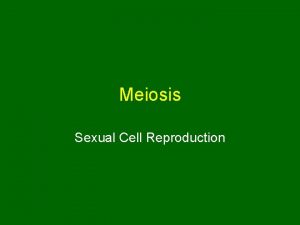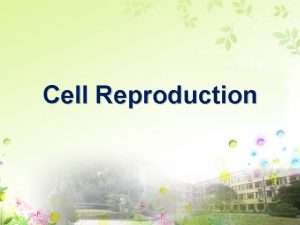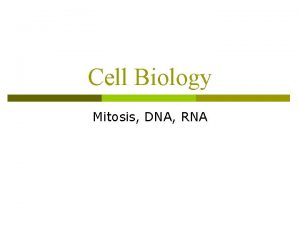Chapter 10 Cell Reproduction Mitosis and Meiosis Mitosis





































- Slides: 37

Chapter 10: Cell Reproduction Mitosis and Meiosis Mitosis Rap

What would happen to a cell if it continued to grow? Calculate the Surface area (Length 2 x 6) and Volume As the length of the cell >, its volume > faster (Length 3) then the Surface area to Volume ratio than its surface area. Surface area to volume ratio would decrease. Makes it difficult to move needed materials in and wastes out of the cell efficiently.

Where is all the genetic information found in a cell? • On the genes on the Chromosomes • Chromosomes are actually DNA and proteins • If cells were the size of a basketball, your DNA would stretch 64 km (40 miles)

A Tale of Tall DNA If you unraveled all your chromosomes from all of your cells and laid out the DNA end to end, the strands would stretch from the Earth to the Moon about 6, 000 times.

Every species has a set number of chromosomes • Chromosome number: – Number of Chromosomes in a body cell – Diploid (2 N) number • Specific for each species of organisms – – – Human – 46 Chimpanzee – 48 Gorilla – 48 Potato – 48 Bat – 44 Fruit fly – 8 Mosquito – 6 King Crab – 208 Dog - 78 Horse – 64 Donkey - 62 Adder’s tongue fern 1, 262

Chromosome structure • Before coiling starts, DNA and proteins w/in nucleus are called Chromatin • DNA starts coiling around a protein histone (spool) • Coiling continues and supercoils • Structure shortens up Chromosome • When DNA makes a copy of itself, the two “twins” are called chromatids & are held together by a centromere


Animation 1


The Cell Cycle • Entire process that a cell undergoes in cell division from start to finish. • Cells grow, prepare for division, divide to form two daughter cells and begin the cell cycle over gain. – Cells such as skin, lining of digestive tract and blood cells go through this process frequently – Introduction

The Cell Cycle

Divided into 2 parts • Interphase – Longest phase of the Cell Cycle – G 1 - “Gap” - Cell grows from last cell cycle – Synthesis of DNA (DNA makes a copy of itself) – G 2 – Cell growth and gets ready for cell division – G 0 – No cell division – typical of cells like nerve cells that stop dividing at maturity • Mitosis – M phase – Prophase – Metaphase – Anaphase – Telophase – Cytokinesis

Interphase Longest part of the cell cycle – over half the time is spent in this phase

Mitosis Division of the nuclear material • Prophase – Prepares for even distribution • Metaphase – Paired chromosomes line up at the equator • Anaphase – Paired chroms separate and migrate to opposite poles • Telophase – Nuclei are formed in each new daughter cell • Cytokinesis – Equal distribution of the cytoplasm and organelles

• Prophase Mitosis – longest phase in Mitosis 1. Copied chromosomes pair up. Held together by Centromere (each is called a chromatid) 2. Shortening up of chromosomes, makes them visible 3. Replicated Centrioles (of animal cells) migrate to opposite poles 4. Nuclear envelope & nucleolus start to break down 5. Spindle fibers (microtubules) extend from centrioles to centromeres

• Metaphase – In the middle phase – Chromosomes line up on the equator (middle)

• Anaphase – “An away they go!” – Chromatids separate and go to opposite poles. Now called chromosomes!! – Spindle fibers shorten up

• Telophase – “the end” – Final phase – Chromosomes reach opposite ends – Cell membrane pinches in (cleavage furrow) or Cell plate forms (if plants) – Chromosomes uncoil – Nuclear membrane & nucleolus reappear – Spindle fibers disassembles

• Cytokinesis – dividing up of cellular contents. Occurs simultaneously with Telophase Mitosis and Cytokinesis




Mitosis Rap Mitosis animations Try them all! • http: //www. sumanasinc. com/webcontent/animations/ content/mitosis. html • cellsalive. • John Kryk • You tube (really good) • Hybrid (love the music) • http: //www. csuchico. edu/~jbell/Biol 207/animations/m itosis. html • Arizona • Movie Clip • Mc. Graw

Difference between Plant and Animal mitosis • No centrioles or asters in plant cells Test yourself • A cell plate forms in plant cells Testing yourself

Mitosis Another

What would happen to our normal chromosome number if the gametes (sex cells) each had 46 chromosomes & reproduced by mitosis? • The chromosome number would constantly be changing – not human 23 + 23 = 46 46 + 46 = 92 92 + 92 = 184

So how do we solve this problem? Meiosis • Process that reduces the chromosome number in half (1 N) during the production of gametes (sex cells). • By doing this, the normal chromosome number (2 N) can be returned at fertilization. 1 N sperm + 1 N egg = 2 N zygote 23 + 23 = 46 (zygote)

Meiosis occurs in two divisions Meiosis I: Interphase I: • Replication of chromosomes. Like chroms are called homologous chromosomes (1 from father & 1 form the mother). Identical (replicated) chromosomes are called sister chromatids Prophase I: • The homologous chromosomes come together (Synapsis) and form a group of 4 called a tetrad. • Twisting & exchange parts of adjacent chromatids will occur – Crossing over • This results in genetic recombination & unlinks genes that are located on the same chromosome.

Anaphase I & Telophase I Homologous Chromosomes separate independently of each other. This is known as Independent assortment. Results in random separation of chromosomes genetic recombination.

At the end of Meiosis I, there are 2 - 1 N cells Meiosis I Results in 2 - 1 N cells Meiosis II Results in 4 -1 N genetically different cells

Meiosis II • Occurs immediately following Telophase I. • NO DNA Replication!! • 1 N cells immediately go into Prophase II, then Metaphase II, Anaphase II, and Telophase II • Split into four 1 N cells, each with unpaired chromosomes At the end of Meiosis II, there are four 1 N cells that are genetically different.



Animation

Meiosis Animations • **http: //www. sumanasinc. co m/webcontent/animations/co ntent/meiosis. html • *John Kryk • Cells Alive • Biology. about • You Tube • http: //www. csuchico. edu/~jb ell/Biol 207/animations/meios is. html • Mc. Graw • ****How Mitosis and Meiosis Differ • One last song!

Gametogenesis Creation of gametes (sex cells) Spermatogenesis (testes) Makes 4 haploid sperm cells from 1 - 2 N primary sperm cell. Looks like normal Meiosis Oogenesis (ovaries) Produces ovum (eggs) from 1 diploid primary egg cell. Difference occurs during cytokinesis during meiosis I and meiosis II. Unequal distribution of the cytoplasm resulting in 1 large ovum and 3 small polar bodies. Polar bodies serve no function in animals but are needed in to plant embryos.

 Cell division mitosis and meiosis
Cell division mitosis and meiosis Two cells are produced
Two cells are produced Mitosis and meiosis concept map
Mitosis and meiosis concept map When does crossing over occur during meiosis?
When does crossing over occur during meiosis? Chapter 10 section 1 meiosis answer key
Chapter 10 section 1 meiosis answer key Chapter 10 meiosis 1 and meiosis 2 answer key
Chapter 10 meiosis 1 and meiosis 2 answer key Asexualk
Asexualk Chapter 6 chromosomes and cell reproduction
Chapter 6 chromosomes and cell reproduction Section 1 meiosis
Section 1 meiosis Chapter 10 section 3 gene linkage and polyploidy
Chapter 10 section 3 gene linkage and polyploidy The disadvantages of sexual reproduction
The disadvantages of sexual reproduction Asexual vs sexual reproduction venn diagram
Asexual vs sexual reproduction venn diagram Mitosis vs meiosis
Mitosis vs meiosis Compare meiosis and mitosis
Compare meiosis and mitosis Difference between meiosis 1 and meiosis 2
Difference between meiosis 1 and meiosis 2 Meiosis reproduction
Meiosis reproduction Write difference between mitosis and meiosis
Write difference between mitosis and meiosis Kesler science biotic and abiotic factors answer key
Kesler science biotic and abiotic factors answer key Gametic cells vs somatic cells
Gametic cells vs somatic cells Mitosis meiosis animation
Mitosis meiosis animation Mitosis purpose
Mitosis purpose Bit.ly/2m8prtt
Bit.ly/2m8prtt Respirometer
Respirometer Cell cycle flip book
Cell cycle flip book Animal chromosome number
Animal chromosome number Chromosome sets (=n) in mitosis and meiosis
Chromosome sets (=n) in mitosis and meiosis Characteristics of mitosis and meiosis
Characteristics of mitosis and meiosis Crossing over meiosis
Crossing over meiosis Chromosome sets (=n) in mitosis and meiosis
Chromosome sets (=n) in mitosis and meiosis Diploid to haploid meiosis
Diploid to haploid meiosis Meiosis 1 and 2
Meiosis 1 and 2 Mitosis vs meiosis double bubble compare and contrast
Mitosis vs meiosis double bubble compare and contrast Chromosome/mitosis/meiosis review answer key
Chromosome/mitosis/meiosis review answer key Mitosis and meiosis jeopardy
Mitosis and meiosis jeopardy Meiosis and mitosis images
Meiosis and mitosis images Prophase cell cycle
Prophase cell cycle The american buffalo has cells containing 60 chromosomes
The american buffalo has cells containing 60 chromosomes Mitosis and meiosis
Mitosis and meiosis







